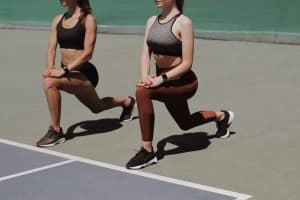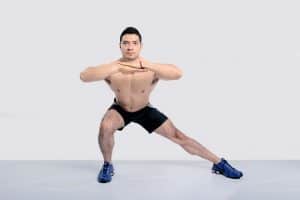Lunges are among the basic workout exercises used in all the gyms and home workout routines. Lunges power up your lower body. Thus, to get rid of those chicken legs or droopy booty, this exercise should become your base. It builds muscle strength and greatly improves your balance. Plus, lungers are a common part of our daily life. You’ll soon notice the ease of many daily (activities).
Now, there are many types of lunges; no need to stick to the basics that you see in most gyms! Besides, forward walking lunges are probably the most injury-prone type of exercise you can find. If done incorrectly, they put too much pressure on the knee and are simply not the most effective.
We suggest incorporating other lunge types into your routine. Depending on its variants, the exercise engages a variety of your lower body muscles. For the best result (and the perfectly-toned body), combine several types to target specific muscles.
How Long Does It Take for Your Butt to Grow?
In fact, the number of lunge types is close to endless. To improve your workouts, we suggest you find several styles that suit your goals and feel comfortable for you. And soon enough, you’ll have a beautiful and toned lower body to keep you strong during workouts and in daily life.
Reverse Lunge
 The reverse is also the primary type of lunges but, unfortunately, not as popular as the walking one. And that is a grievous mistake. Reverse lunges offer more stability, decrease the pressure on knees, but still offer excellent strength development. If you suffer from occasional knee pains, this is the type for you. You’ll also notice better hip flexibility and inner balance. Reverse lunges correctly target the proximal hamstring and glutes.
The reverse is also the primary type of lunges but, unfortunately, not as popular as the walking one. And that is a grievous mistake. Reverse lunges offer more stability, decrease the pressure on knees, but still offer excellent strength development. If you suffer from occasional knee pains, this is the type for you. You’ll also notice better hip flexibility and inner balance. Reverse lunges correctly target the proximal hamstring and glutes.
How to do lunges:
- Feet shoulder-length apart, hands in front of your chest
- With one foot, take a step back, approximately the same length as you would lunger forward.
- Bends both knees until both the front leg squad and the back leg shin parallel the floor.
- Return to the starting position.
- Switch legs.
A quick note: Keep your cervical spine neutral and take your time. No need to rush this exercise. If additional weight is needed, take barbells to up the routine.
Curtsy Lunge
A curtsy lunge is very similar to the reserve one but works wonders for your inner and outer glutes. What are lunges for glutes? For those looking to crave a perfect butt, this should become a go-to exercise. The unique positioning of the back leg engages all three glute muscles and tones them nicely. Core, quadriceps, and calves are in work as with other types of lunges as well.
How to do:
- Initial position the same: feet apart, hands in front
- Take a large step diagonally back.
- Lower your knee to almost touching the ground (keep your front leg bent at 90 degrees).
- Return to the starting position.
- Switch legs.
Note: Keep your back straight and engage core muscles. Your weight should be on the front leg.
Front Foot Elevated
This type is the same as the reverse lunges workout with a bit of additional equipment. This lunge type brings even better knee stability and even builds its strength.
These few inches of elevation load glutes and hamstrings right from the start, thus bringing more stability.
Glute Bridge Exercises for a Firm Peach
How to do:
- Put one leg on an aerobic step or any plate 2-4 inches tall. Put your weight on this leg.
- Move your other leg behind and drop your knee to the ground. Keep the movement slow and controlled.
- Get to the initial position and repeat.
Note: Maintain the front glutes parallel to the floor. Make sure to engage and keep tension in the posterior chain. The heel of your elevated foot should be firm on the surface at all times.
Lateral Lunge
 Finally, a lunge that works in different dimensions. Unlike the standard lunges that imply the forward-back movement, lateral lunges are all about engaging your sides.
Finally, a lunge that works in different dimensions. Unlike the standard lunges that imply the forward-back movement, lateral lunges are all about engaging your sides.
The side-step phase of this lunge ankle mobility, works on your balance, and targets the inner thighs that only a few other lunges can do. With the addition of engaging all glute muscles, lateral lunges create a beautiful lower body shape that gives the best results for women.
How to do:
- The initial position: feet together, hands on your waist.
- Take a big to one side (around 2 feet)
- Hinge forward at the hips and move buttocks back.
- Bend your knee to a lunge.
- After a second, return to the initial position.
- Repeat with the other leg.
Note: Keep your back straight, weight on your heels. The leading leg should be bent at around 90 degrees.
Rear Foot Elevated
This split lunge squat (also known as Bulgarian) creates the most tension in the glutes and quads. It will also make you sweat like no other type!
The lunge also requires equipment for elevation but something taller than for the previous type. Look for something with the height of a gym bench. Make sure that the foot feels comfortable on it. For added weight, you can use dumbbells. Though, we advise starting with bodyweight in order to be more flexible in maintaining balance.
The main advantage of this lunge type is the simultaneous engagement of muscles and their flexibility.
How to do:
- Place a bench behind you.
- Place one foot on it. Fix this position.
- Slowly bend the front knee and descent until your back knee almost touches the floor.
- Return to the initial position and repeat.
Note: Make sure the front knee doesn’t slide past your toes. For better stability, move closer to a wall and keep one hand “grounded.”
11 Best Butt Exercises to Do at Home
These are the basic lunge variations that will gift you a beautifully toned lower body if you keep persistent and regularly incorporate them into your routine. In all these exercises, you can work both with your bodyweight and take additional weights when you refine the techniques. Remember that lunges are highly dependent on the right technique. Moreover, if you butcher your lunges, negative repercussions will traumatize your knees and, with some lunges, ankles. Thus, we strongly advise doing the reps in front of a mirror to see whether you are doing them right.
Also, check out this home workout equipment to keep fit during the lockdown.
 Fact checked by
Fact checked by